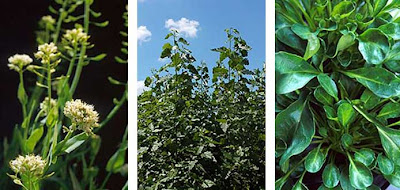 |
| Plants commonly used for phytoremediation (Source: ARS.USDA.gov photo gallery) |
Triple E Agent Assignment:How is this 'emerging' technology or approach being used?
Describe basics of bio- and phyto- remediation...
Bioremediation is defined as the elimination, attenuation or transformation of polluting or contaminating substances by the use of biological processes. Bioremediation of subsurface media is successful when the metabolism (e.g., growth and/or reproduction) of microorganisms are enhanced. Microorganisms are ubiquitous in soil and water media; therefore, they are capable of remediating nearly any organic contaminant under the proper conditions. For microorganisms to thrive they require nutrients and an energy (i.e., carbon) source, both of which may be derived from an organic contaminant or may be available in the media. Organic contaminants are most readily remediated by microorganisms because organics and microorganisms are comprised of the same basic elements or building blocks. More often, amendments must be made to the soil or water to make nutrients bioavailable, or catalyze microbial processes. Amendments may include nutrients, oxygen, carbon source (i.e., “sugar”), enzymes, or other substances.
As a sub-type of bioremediation, phytoremediation uses living plants to remove, or degrade contaminants. Some plants used in phytoremediation are effective for remediating organics and heavy metals, and have been shown to hyperaccumulate chemicals that are toxic to other organisms. When aluminum, cadmium, nickel, zinc or even radioisotopes (such as uranium) are elevated above background levels – plants such as thale grass (Arabidopsis thaliana) and alpine pennycress (Thlaspi caerulescens) have been effective as shown by USDA Agricultural Research Station. Fast growing, deep-rooting woody plants such as the hybrid poplar and willow trees are commonly used for phytoremediation as described by Deep Root. These plants and trees have the ability to extract toxic elements or compounds from soil and water, and then concentrate them into the stems, leaves or woody tissue. Biomass can then be harvested, reduced in volume, disposed, or put to a beneficial use (e.g., biofuel).
Other articles related to this topic are in preparation.
To Be Continued,
Triple E.
No comments:
Post a Comment